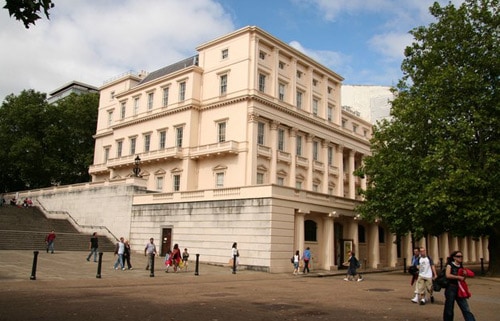
By Margaret Harris
I have a mental block about Carlton House Terrace. This elegant little street in central London is home to several of the UK’s national academies, including the Royal Society and the Royal Academy of Engineering (RAEng), and I’m sure I’ve visited it at least half a dozen times. Yet somehow, whenever I emerge from Charing Cross underground station in the middle of Trafalgar Square, I never know which way to go next.
Fortunately, this is the 21st century, so when the usual disorientation struck me yesterday on my way to an “Innovation in Space” event at the RAEng, I simply pulled out my smartphone. Within seconds, an app told me exactly where I was (plus or minus a few metres) and how to walk from there to 3 Carlton House Terrace. Minutes later, I was safely ensconced in the seminar room, nodding in agreement as the event’s chair, Sir Martin Sweeting, explained how space-related innovations – including, ahem, the network of satellites that make up the Global Positioning System (GPS) – have become an integral part of our daily lives.
One of the messages I took away from a busy afternoon of talks was that in terms of impact on daily life, the GPS-driven app that directed me to Carlton House Terrace is really just the beginning. In one talk, Chaz Dixon, deputy chief technical officer at the UK’s Satellite Applications Catapult, explained that in the future, global navigation satellite systems like the GPS will also be crucial for developing intelligent transport systems. Such systems, though still in their infancy, promise to make our roads safer, cleaner and less congested by monitoring traffic remotely and managing how it flows.
But as Dixon later pointed out, the GPS network is also emblematic of a major challenge facing the space industry. Built for the US military in the 1970s but freely accessible to anyone with a receiver, the GPS has proved a huge commercial success; according to Dixon, tax revenues from GPS-dependent industries have repaid the government’s investment and then some. That success certainly didn’t happen overnight, though, and as another speaker, Samantha Lavender, observed, this creates a problem for politicians and policymakers. Lavender, who chairs the British Association of Remote Sensing Companies and also co-founded her own firm, Pixalytics, noted that the UK has seen a “really great period” of government investment in space recently. However, sustaining that investment in the future is going to require proof – probably in the form of additional tax revenues.
At first glance, the UK’s space industry looks big. It employs 80,000 people and generates about £11bn in revenue every year. However, I’d heard somewhere that £10bn of this figure comes from Sky, the satellite-based broadcaster, and when I asked Sweeting about this during the event, he confirmed that it was true. All the country’s other hi-tech space firms, from major manufacturers down to small consultancies like Pixalytics, contribute only about £1bn to the total.
This isn’t just a UK issue, though, Sweeting explained. In general, around 80% of the space industry’s revenue comes from “downstream” services rather than the “upstream” satellites and technology that make them possible. That imbalance may have been on the mind of Craig Clark, CEO of the Glasgow-based firm Clyde Space, when he observed in the day’s closing session that innovation isn’t just about technology. One can, he said, also be innovative in delivering services and meeting the needs of customers. And that’s true regardless of whether the customer is a national space agency, an intelligent-transport start-up – or just a science journalist trying to navigate through central London.



